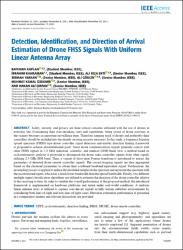Detection, identification, and direction of arrival estimation of drone fhss signals with uniform linear antenna array

View/
Access
info:eu-repo/semantics/openAccessDate
2021Author
Kaplan, BatuhanKahraman, İbrahim
Ekti, Ali Rıza
Yarkan, Serhan
Görçin, Ali
Özdemir, Mehmet Kemal
Çırpan, Hakan Ali
Metadata
Show full item recordAbstract
Safety, security, and privacy are three critical concerns affiliated with the use of drones in everyday life. Considering their ever-shrinking sizes and capabilities, being aware of drone activities in the vicinity becomes an important surveillance item. Therefore, keeping track of drones and preferably their controllers should be included into the already-existing security measures. In this study, a frequency hopping spread spectrum (FHSS) type drone controller signal detection and emitter direction finding framework is proposed to achieve aforementioned goals. Since drone communications signals generally coexist with other FHSS signals in 2.4 GHz industrial, scientific, and medical (ISM) band, first, a method based on cyclostationarity analysis is proposed to distinguish the drone radio controller signals from other signals utilizing 2.4 GHz ISM band. Then, a variant of short-term Fourier transform is introduced to extract the parameters of detected drone remote controller signals. The correct hopping signals are then aggregated based on the clustered parameters to obtain their combined baseband equivalent signal. Furthermore, the resampling process is applied to reduce the unrelated samples in the spectrum and represent the spectrum with the reconstructed signal, which has a much lower bandwidth than the spread bandwidth. Finally, two different multiple signal classification algorithms are utilized to estimate the direction of the drone controller relative to the receiving system. In order to validate the overall performance of the proposed method, the introduced framework is implemented on hardware platforms and tested under real-world conditions. A uniform linear antenna array is utilized to capture over-the-air signals in hilly terrain suburban environments by considering both line-of-sight and non-line-of-sight cases. Direction estimation performance is presented in a comparative manner and relevant discussions are provided.

















